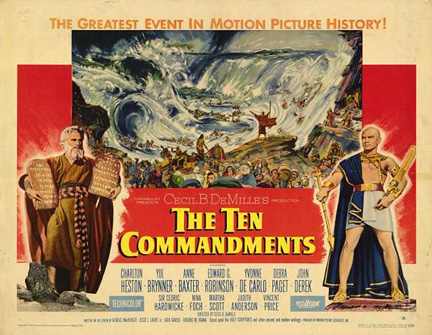 Many are taught that "The Ten Commandments" are ten simple "thou shalt nots" that spell out how to live your life, written by God himself on tablets of stone. But, in addition to the Commandments having little to do with our lives and modern sense of ethics, there are other problems and confusions that occur concerning the commandments when you examine the text of the Bible. There are more than ten commandments, first of all. There are hundreds. And it's difficult to say which ones, if any, were written on stone. The Bible does eventually give us a list of ten commandments, but they are not the popular ones we sorta kinda think we know. There is much to sort through and discuss concerning this topic, so we'll walk through it slowly.
Many are taught that "The Ten Commandments" are ten simple "thou shalt nots" that spell out how to live your life, written by God himself on tablets of stone. But, in addition to the Commandments having little to do with our lives and modern sense of ethics, there are other problems and confusions that occur concerning the commandments when you examine the text of the Bible. There are more than ten commandments, first of all. There are hundreds. And it's difficult to say which ones, if any, were written on stone. The Bible does eventually give us a list of ten commandments, but they are not the popular ones we sorta kinda think we know. There is much to sort through and discuss concerning this topic, so we'll walk through it slowly.
It begins simply enough. God allows Moses' people to escape slavery by bringing ten plagues upon Egypt and then killing their pursuers in the Red Sea. Moses makes it to Mount Sinai, where God comes down in the form of fire. Moses' company is instructed not to touch the mountain or get too close or they'll die. There's lots of thunder and trumpet blasts. It's all very Wizard of Oz, and it sometimes seems as if Moses is just making things up, saying that the words are from God, and asking everyone not to pay attention to that man behind the curtain. But, of course, we're supposed to imagine that God himself really is saying and doing these things, so that's what we'll do.
At this point God begins to instruct the people, giving what are commonly known as "The Ten Commandments," even though the book doesn't call them that here and I'm not so sure they add up to ten. They are as follows, with commentary by me. Since I've heard over and over that the Ten Commandments are the basis of many contemporary laws, including those of the United States, I'll discuss them in relation to the current laws of our country. Penalties for breaking these commandments are also worth noting, so I'll list those. If you want to read along with me in your preferred translation (I'm, as usual, using the New Revised Standard Version), you can find "The Ten" in Exodus 20. They appear again, slightly modified, in Deuteronomy 5.